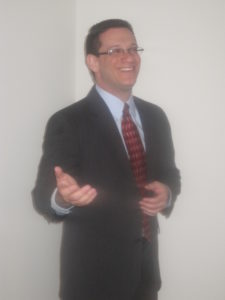Let’s Shake Hands And Disagree: Who’s Right?
Earlier this month, I wrote an article called, “What Should I Do With My Hands?” Another trainer took to his blog to disagree with my advice – so this article will look at both sides of the debate.
Here’s the part of my original story that Matt Eventoff, a friend and president of Princeton Public Speaking, disagreed with:
The key is never to “lock” or “hide” your hands. No clasped hands, no hands behind the back, no hands in pockets, and no “steepled” fingers, which is when your fingertips touch one another….My preference is to nest your hands in one another, keeping them at navel-level when not gesturing. Nesting is a nice option, since it allows you to gesture freely when making an important point.

Nesting one hand gently in the other prevents speakers from looking defensive and allows for natural gesturing. Photo credit: Ms. Media Training
There are two parts of Matt’s rebuttal I’d like to address. First, he wrote:
“Utilizing either ‘the steeple’ or ‘the nest’ for your hands while speaking may work very well; or you may appear guarded…The rationale: Every person is an individual, and what works for one person may, or may not, work for another…just as no two individuals are alike, no two speaking styles are alike; one body language principle may work for 95% of the population, but it may not work for you!”
He’s absolutely right. I don’t insert that disclaimer in every blog post – doing so would unnecessarily weigh down the writing – but it certainly applies to every post. The media and presentation training advice dispensed from this blog is intended to apply to the majority of readers, but he’s quite correct that there are always exceptions to the rule.
I disagree with Matt on his second point:
“Nested hands can certainly evoke a relaxed response from both the presenter and the audience. I tested this with a few trainees this week – one thing I noticed is that when a speaker is in a state of heightened anxiety or nervousness, nested hands can lead to locked arms that look like an awkward “ball and socket” joint.
This tends to not only make the presenter appear more anxious, it actually can make the presenter more anxious, as the nervous energy has no outlet to escape – you have essentially created a nonstop loop with no escape route.”
Although I appreciate Matt’s openness to trying this with his own clients, I’d suggest that a one-week trial run isn’t long enough to reach any conclusions. Perhaps they weren’t “nesting” the same way I’d advise them to, or perhaps they truly were the exceptions to the rule.

Gesturing is easy from a nesting position, since the hands have less distance to travel. Photo credit: Ms. Media Training
I’ve observed my clients using this technique over the past decade, and it usually works. The “escape route” for nervous energy comes from gesturing itself, and nesting puts the hands closer to where they need to be for gesturing.
Therefore, I stand by my original advice on this point – but Matt’s caution will definitely make me look harder for the “ball and socket” joint dynamic he describes.
Still, Matt is right on his overall point. Every speaker is different, and effective media and presentation trainers never try to apply a one-size-fits-all strategy to their clients.
